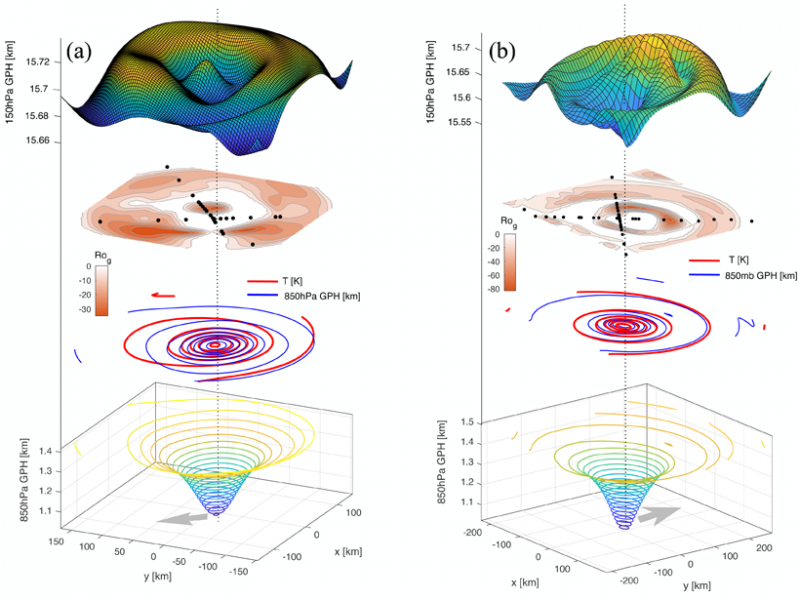Examining the Structure of Tropical Cyclones' Upper Levels
Unique observations used to examine the structure and mass balance of hurricanes' top levels find that regions of high pressure violate the gradient wind balance.
SOURCE: Geophysical Research Letters

Hurricane Joaquin's (2015) 3-D structure is depicted with (from bottom to top) contour plots of the 850hPa geopotential height, the corresponding 850hPa temperature with the positions of the dropsonde deployment (black dots), the overlap of the column integrated temperature and 850hPa temperature, and a surface map of the criteria for the non-gradient wind balance evaluated at the 150hPa geopotential height. The gray arrow points in the direction of storm movement. The left column figures were obtained from data from on October 2, the right column figures from October 3 data. Credit: Cohen et al. [2019], Figure 4
By Suzana Camargo 12 November 2019
In most hurricane idealized models there is an assumption of a simple force balance (gradient wind balance), which makes the winds at the surface decoupled from the upper levels. However, previous model simulations showed that a region of high pressure develops at upper levels in hurricanes and that the gradient wind balance is violated in these regions [Cohen et al. 2017].
In a follow up paper, Cohen et al. [2019] examine the structure of hurricanes at upper levels using new field campaign observations. The observations provide data for the structure of the hurricane upper levels and confirm those models. These new observational results illustrate a very important aspect of the upper level dynamics of tropical cyclones that is often overlooked in the characterization of dynamic balance at the top of the storm and may play a role in changes in storm structure and intensity.
This is one of the first papers to examine the structure and mass balance of hurricane upper levels and points to the need of new idealized theories for hurricanes. Furthermore, the impacts of this non-balance in hurricane intensity could potentially lead to improvements of hurricane intensity forecasts.
Citation: Cohen, Y., Durden, S. L., Harnik, N., & Heifetz, E. [2019]. Relating Observations of Gradient Nonbalance at the Top of Hurricanes With Their Warm Core Structures. Geophysical Research Letters, 46. https://doi.org/10.1029/2019GL084248
—Suzana Camargo, Editor, Geophysical Research Letters
AGU发布最新国外工作学习机会:
1. Full-Tuition Scholarships & Stipends for PhD & MS Students at Syracuse University
Syracuse, NY
Syracuse University Department of Earth Sciences
All students are supported by full-tuition scholarships and stipends through teaching assistantships, research assistantships, and/or fellowships. Typically, M.S. students receive a minimum of four semesters of support, and Ph.D. students receive a minimum of eight.
2. Postdoctoral Positions in Geodynamics, CIG University of California, Davis
Univesrsity of California, Davis
$50,760 to $61,308 depending on post-doctoral research experience.
Computational Infrastructure for Geodynamics
We seek proposals for innovative, original, and feasible software engineering and/or software development projects that complement and/or improve our current practices. CIG supports communities in computational science, dynamo, education, long-term tectonics, mantle convection, multiphysics, seismology, and short-term crustal dynamics.
3. Two PhD Positions in Glacier Applied Geophysics
Lausanne, Switzerland
Institute of Earth Sciences, University of Lausanne
The PhD positions are funded for four years and the starting date is April 1, 2020, or a slightly earlier or later date to be decided upon. Successful candidates will have a strong quantitative and computer programming background, and hold a Master's degree in geophysics, physics, engineering, or a related quantitative discipline.
https://findajob.agu.org/job/8011612/two-phd-positions-in-glacier-applied-geophysics/
4. Summer Student Internships at Air Force Research Labs
Albuquerque, New Mexico
$969.60 per week for Masters students and $1173.20 per week for PhD students
Air Force Research Labs
An intern may become involved with source physics modeling, a model comparison study, or a new project we develop based on the intern's background.
https://findajob.agu.org/job/8011468/summer-student-internships-at-air-force-research-labs/
5. The Foster and Coco Stanback Postdoctoral Fellowship in Global Environmental Science
Pasadena, California (US)
Caltech, Division of Geological and Planetary Sciences



